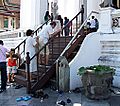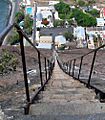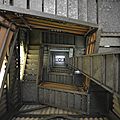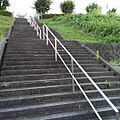Stairs facts for kids
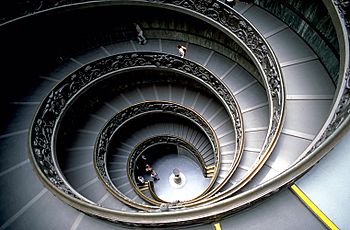
Stairs, also called a staircase or stairway, are a way to go up or down a big distance by breaking it into smaller steps. Stairs can be straight, round, or have turns.
Some special types of stairs are escalators and ladders. Other ways to move between floors include elevators and moving walkways.
Contents
Parts of a Staircase
What Makes a Step?
Each step on a staircase has two main parts: the tread and the riser.
- Tread - This is the flat part of the step that you walk on. It's built to be strong, like a floor.
- Riser - This is the vertical part between one step and the next. Sometimes, stairs don't have risers, making them look "open."
- Nosing - This is the edge of the tread that sticks out a little bit over the riser below it.
- Bullnose - This is a rounded, wider first step at the bottom of a staircase. It's used when the stairs are open on one or both sides. A double bullnose means both sides are rounded.
- Winders - These are steps that are narrower on one side. They help stairs change direction without needing a flat landing. Many winders together make a spiral or circular staircase. A kite winder is a diamond-shaped step used in a 90-degree turn.
- Stringer - This is the strong support beam that holds up the treads. Stairs usually have two stringers, one on each side.
The Railing System
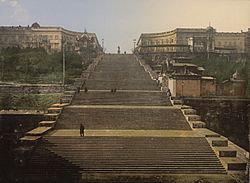
The balustrade is the whole system of railings and posts that stops people from falling off the edge of the stairs.
- Handrail or Banister - This is the angled bar you hold onto as you go up or down. It's held up by vertical posts. Big staircases might have railings on both sides, or even in the middle.
- Volute - A handrail that spirals like a snail shell, often found at the bottom of the stairs.
- Gooseneck - A curved part of the handrail that connects a sloped handrail to a higher, flat handrail on a landing.
- Baluster - These are the vertical posts that hold up the handrail. They are sometimes called spindles or guards.
- Newel - This is a large, strong post that anchors the handrail. It goes all the way down to the floor's support beams. A half-newel is used when a railing ends against a wall.
Handrails can be continuous (meaning they flow smoothly over the newel posts) or post-to-post (where the newel posts stick up above the handrails).
Other Stair Terms
- Balcony - If the top floor or a landing is open, it acts like a balcony overlooking the space below.
- Flight - A flight is a set of steps without any breaks or landings.
- Floating stairs - These stairs look like they are floating because they have nothing underneath them. They often don't have risers, making them look very open.
- Landing or Platform - This is a flat, intermediate floor between flights of stairs. Landings are used to let stairs change direction or give people a place to rest.
- Runner - This is a piece of carpet that runs down the middle of the stairs.
- Spandrel - This is the triangular space underneath a staircase, often used as a closet.
- Stairwell - This is the open space in a building where the stairs are built.
- Staircase - This term usually means the steps, railings, and landings themselves.
- Stairway - This term often refers to the entire stairwell and staircase together.
How Stairs Are Measured
- Rise height - This is the vertical distance from the top of one step to the top of the next.
- Tread depth - This is the horizontal distance from the edge of the step (nosing) to the riser. It's also called the going.
- Total run - This is the total horizontal distance from the first step's riser to the last step's riser.
- Total rise - This is the total vertical height that the stairs cover, from one floor to the next.
- Slope - This is how steep the stairs are. It's calculated by dividing the total rise by the total run. It's also called the rake or pitch.
- Headroom - This is the clear height from the top of a step to the ceiling above it.
- Walkline - For curved stairs, this is an imaginary line where people are expected to walk. Building rules often say how wide the steps must be at this line.
- To count steps, you count the number of risers, not the number of treads.
Famous Stairways Around the World
- The longest stairway in the world is the service stairway for the Niesenbahn railway in Switzerland. It has an amazing 11,674 steps and goes up 1,669 meters (5,476 feet)! Only employees can use these stairs.
- The Haiku Stairs in Hawaii have about 4,000 steps and climb almost half a mile up a mountain. They were first used to reach radio antennas. Today, they are closed to hikers.
- The Penrose stairs are a famous "impossible object" created by Lionel and Roger Penrose. The drawing makes the stairs look like they go on forever, which is impossible in real life. Artist M. C. Escher used this idea in his famous artwork Ascending and Descending.
Related pages
Images for kids
-
A floating staircase in Minneapolis
-
A staircase in a Ford plant in Los Angeles with a double bullnose and two volutes.
-
The Yerevan Cascade, a giant stairway made of limestone in Armenia
-
Wooden stairs at the shores of Lake Iso-Melkutin in Loppi, Finland
-
The Crown Princess of Sweden on a historic staircase in Stockholm Palace.
-
A staircase in Aarhus City Hall, Denmark.
-
A double spiral staircase in Yangon.
-
The outside spiral staircase of Palazzo Contarini del Bovolo, Italy.
-
An alternating tread stair climbing a steep slope in Pinnacles National Park, California.
-
A model of an alternating tread stair built with Duplo blocks.
-
The "Miracle Stair" at Loretto Chapel in Santa Fe, New Mexico, which has no central support.
-
Looking up at the Tulip Stairs at the Queen's House, Greenwich, England.
-
A spiral stairway seen from below at Melk Abbey, Austria.
-
The wooden spiral stairs of the Tour de Sauvabelin in Lausanne.
-
A Tudor staircase at Madingley Hall, England.
-
The 66 steps of the Queen's Staircase in Nassau, Bahamas.
-
The spiral (double helix) stairs of the Vatican Museums.
-
Stairs at Ise Jingu in Japan.
-
Steps at Angkor Wat in Cambodia.
-
A modified stairway in Thailand designed for older people.
-
Jacob's Ladder in Saint Helena.
-
An outdoor stairway on the Alameda Ridge in Portland, Oregon.
-
The staircase in the 19th-century theatre of Weißenhorn, Germany.
-
Wooden spiral stairs inside the tower of Salisbury Cathedral, England.
-
A stair and a sculpture in the Fontevraud Abbey.
-
A Nabataean stairway in Beida ("Little Petra"), Jordan.
-
Many stairs inside the Federal Palace of Switzerland.
-
A spiral stairway in the Alabama State Capitol.
-
The Rue Foyatier in Montmartre, Paris.
-
Georgian stairs in Dublin, Ireland.
-
Heated stairs in Trondheim, Norway.
See also
 In Spanish: Escalera para niños
In Spanish: Escalera para niños






































